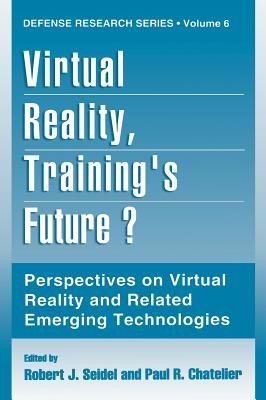
- We will send in 10–14 business days.
- Publisher: Springer
- Year: 1997
- ISBN-10: 0306454866
- ISBN-13: 9780306454868
- Format: 17.8 x 25.4 x 1.4 cm, hardcover
- Language: English
- SAVE -10% with code: EXTRA
Virtual Reality, Training's Future? (e-book) (used book) | bookbook.eu
Reviews
Description
In 1988, the NATO panel governing human sciences (Panel 8 on Defence Applica- of Human and Bio-Medical Sciences) established a Research Study Group to synthe- tions size information relevant to Advanced Technologies Applied to Training Design. During its first phase, the RSG established an active exchange of information on advanced tech- nologies applied to training design and stimulated much military application of these tech- nologies. With the increased emphasis on training throughout the alliance, Panel 8, during its April 1991 meeting decided to continue with Phase II of this RSG focusing in the area of advanced training technologies that were emerging within the alliance. In order to ac- complish its mission, the RSG held a series of workshops. Leaders in technology and training were brought together and exchanged information on the latest developments in technologies applicable to training and education. This volume represents the last in a se- ries based on the NATO workshops. In Part One, it details findings from the last work- shop, Virtual Reality for Training; and in Part Two, we provide a summary perspective on Virtual Reality and the other emerging technologies previously studied. These include computer-based training, expert systems, authoring systems, cost-effectiveness, and dis- tance learning. It is a natural extension to proceed from learning without boundaries to virtual envi- ronments. From the extended classroom to the individual or team immersion in a distrib- uted, virtual, and collaborative environment is an easy conceptual step.
EXTRA 10 % discount with code: EXTRA
The promotion ends in 20d.07:44:49
The discount code is valid when purchasing from 10 €. Discounts do not stack.
- Publisher: Springer
- Year: 1997
- ISBN-10: 0306454866
- ISBN-13: 9780306454868
- Format: 17.8 x 25.4 x 1.4 cm, hardcover
- Language: English English
In 1988, the NATO panel governing human sciences (Panel 8 on Defence Applica- of Human and Bio-Medical Sciences) established a Research Study Group to synthe- tions size information relevant to Advanced Technologies Applied to Training Design. During its first phase, the RSG established an active exchange of information on advanced tech- nologies applied to training design and stimulated much military application of these tech- nologies. With the increased emphasis on training throughout the alliance, Panel 8, during its April 1991 meeting decided to continue with Phase II of this RSG focusing in the area of advanced training technologies that were emerging within the alliance. In order to ac- complish its mission, the RSG held a series of workshops. Leaders in technology and training were brought together and exchanged information on the latest developments in technologies applicable to training and education. This volume represents the last in a se- ries based on the NATO workshops. In Part One, it details findings from the last work- shop, Virtual Reality for Training; and in Part Two, we provide a summary perspective on Virtual Reality and the other emerging technologies previously studied. These include computer-based training, expert systems, authoring systems, cost-effectiveness, and dis- tance learning. It is a natural extension to proceed from learning without boundaries to virtual envi- ronments. From the extended classroom to the individual or team immersion in a distrib- uted, virtual, and collaborative environment is an easy conceptual step.


Reviews